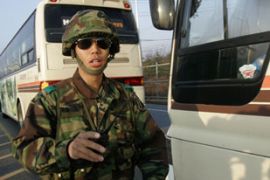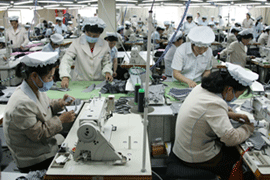Koreas restore cross-border traffic
North Korea allows traffic to resume in latest sign of possible thaw in relations.

Tougher policies
With the measures now eased, the border will open 23 times a day, up from the previous six times, a spokeswoman for South Korea’s Unification Ministry told reporters on Tuesday.
She added that the number of people and vehicles allowed to cross the border at one time will no longer be restricted.
| Signs of a thaw |
|
|
The Kaesong factory park is home to about 110 South Korean-run factories, employing about 40,000 North Korean workers.
The park is an important source of foreign income for North Korea, but is also one of the few active joint projects between the two Koreas.
Most co-operation broke down after Lee Myung-bak, South Korea’s current conservative president, took office early last year implementing a programme of tougher policies towards North Korea.
Lee’s harder line, such as linking supplies of aid to progress on nuclear disarmament, angered North Korea which cut off links warning that the South Korean president was pushing the peninsula “to the brink of war”.
North and South Korea remain officially at war, never having signed a formal peace treaty ending the 1950-53 Korean War.
Strained ties
However, recent developments have signalled a possible easing of tensions, following months of increasingly strained ties which saw North Korea conduct a series of missile tests and carry out its second nuclear test.
 |
| The Kaesong factory park is an important earner for North Korea [GALLO/GETTY] |
Last month North Korea freed a South Korean employee of the Kaesong factory park who had been detained for more than four months, allegedly after insulting the North Korean leadership.
Later a delegation of North Korean officials visited South Korea to pay respects at the funeral of Kim Dae-jung, the former South Korean president and architect of the so-called Sunshine Policy of engagement with the North.
They also held talks with Lee, the current South Korean president, in what was his highest-level contact with the North since taking office.
And on Friday envoys from North and South Korea agreed to resume a programme of temporary reunions of families divided since the end of the Korean War.
The reunions, a highly emotive issue in both Koreas, had been suspended since late 2007.
‘Hostile policy’
In a separate development on Tuesday, North Korean state radio quoted the country’s leader, Kin Jong-il, repeating calls for the US to end what he called its “hostile policy” toward the North.
According to the report, which did not say when Kim made the remarks, the North Korean leader also called for the US to sign a peace treaty with North Korea as a path toward reducing tensions.
A spokesman for the state department in Washington said he had no comment.
US forces fought alongside South Korean troops in the Korean War, and around 28,000 US troops remain based in South Korea.
 August 13: South Korean worker Yoo Seong-jin freed from detention after four months in North.
August 13: South Korean worker Yoo Seong-jin freed from detention after four months in North.